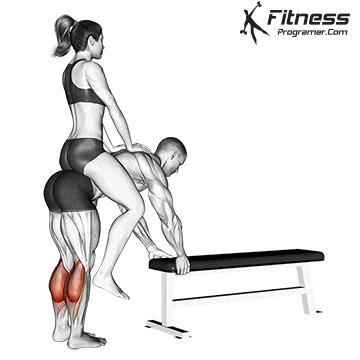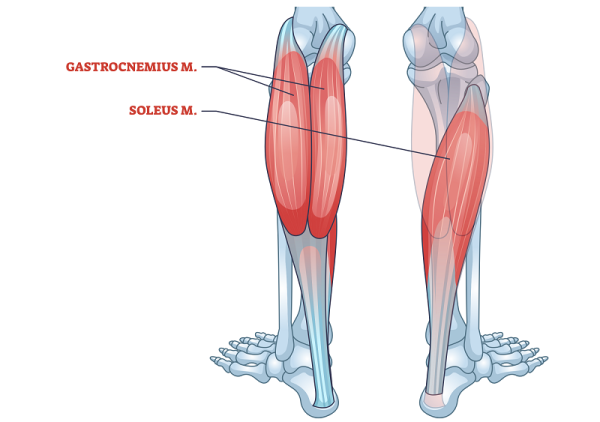Overview
The partner-loaded donkey calf raise is a traditional calf exercise made famous by Golden Era bodybuilders. Unlike machine-based variations, this version uses a training partner seated on the lower back to provide external resistance. The lifter bends forward at the hips and performs calf raises while maintaining knee extension and a deep stretch at the ankle.
This variation is not only accessible without gym equipment—it also provides a natural overload progression and intense contraction stimulus, particularly for lifters chasing hypertrophy or peak gastrocnemius development. This classic approach is both effective and nostalgic—mimicking the exact method used by Arnold Schwarzenegger and other legendary physiques in the 1970s.
How to Perform the Donkey Calf Raise with a Partner

Foot Placement: Stand on a secure block or platform with just the balls of your feet supported and heels hanging off the edge.
Torso Position: Bend forward at the hips to form a roughly 90° angle. Place your hands on a secure bench, rail, or platform for stability. Keep your back flat and knees fully extended.
Partner Loading: Your partner carefully mounts your hips/lower back area and sits evenly. They should distribute weight without applying direct pressure to the spine or ribs.
Starting Position: Begin with your heels fully lowered to achieve a deep calf stretch.
Initiate the Lift: Raise your heels by pressing through the balls of your feet, contracting your calves forcefully.
Top Squeeze: Hold at the top for 1–2 seconds, focusing on full plantarflexion.
Controlled Descent: Lower the heels back below the block level under slow control, reestablishing the stretch.
Repeat: Complete the desired number of reps, maintaining a consistent tempo and posture throughout.
Tips for Proper Form
Choose a partner close to your weight class to start, then scale up.
Ensure even load distribution—the partner should sit on the hips, not the mid-back.
Keep knees fully locked out to prioritize gastrocnemius recruitment.
Avoid bouncing or using momentum—focus on slow, deliberate movement.
Maintain a neutral spine and consistent hip hinge throughout the set.
Common Mistakes to Avoid
Letting the partner sit too high, which strains the lumbar spine and reduces mechanical tension on the calves.
Bending the knees, which shifts focus to the soleus and compromises form.
Failing to use a stable surface—a slipping foot platform can cause falls.
Overloading too early, risking injury or breaking form.
Using arms to pull or push, reducing lower-body isolation.
Benefits of the Partner Donkey Calf Raise
Maximizes gastrocnemius loading with a deep stretch and full contraction range.
Portable and equipment-free—perfect for home gyms or outdoor workouts.
Allows high-volume training with minimal joint stress.
Enhances Achilles tendon and ankle strength through controlled eccentric loading.
Mimics the most hypertrophy-effective conditions: extended muscle length and peak tension.
Provides old-school training stimulus popularized by physique legends.
Enables progressive overload by scaling partner size or adding backpacks.
How to Incorporate Into Your Routine
For Beginners: Perform bodyweight donkey raises with no partner first. Once consistent control is built, progress to a lightweight partner for 2–3 sets of 8–10 reps.
For Hypertrophy: Perform 3–5 sets of 10–15 reps using a partner close to or slightly heavier than your own bodyweight. Focus on deep stretches and long contractions.
For Functional Training: Incorporate as a loaded ankle plantarflexion drill post-squat or sprint session to reinforce full ROM strength.
For Bodyweight Programs: Use the partner-loaded variation as a primary calf builder where machines and resistance bands aren’t available.
For Group or Buddy Workouts: Alternate sets with your training partner for time-efficient training and added motivation.
Donkey Calf Raise: Muscles Worked

Frequently Asked Questions
Is this safe for my lower back?
Yes, if your partner sits properly on the hips or glutes—not the spine—and you maintain a neutral back. Always warm up first and start with light resistance.
What’s the benefit of using a partner versus a machine?
Partner resistance creates natural instability, which can increase neuromuscular engagement. It’s also convenient in settings without equipment.
Can I add even more weight?
Yes. Advanced trainees sometimes wear a weighted vest or backpack while using a partner for added resistance—but only with proper control and supervision.
Is it better than seated calf raises?
They target different muscles. The donkey variation emphasizes the gastrocnemius, while seated raises focus on the soleus. Use both for full calf development.
How often should I train this variation?
2–3 times per week works well, especially when rotating with machine-based or unilateral calf raises.
